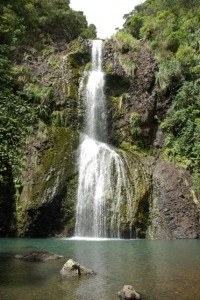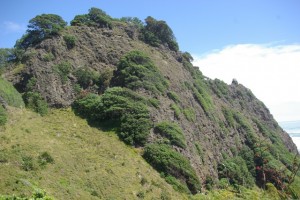The dramatic rugged landscapes of Piha and the surrounding area were created by volcanic activity millions of years ago. An undersea volcano, Waitakere Volcano, 5 or 6 times the size of Ruapehu, Ngaruahoe and Tongariro combined, existed 20 km west of today’s Waitaker Ranges and erupted periodically over a 6 to 7 million peridocally eventually piercing the waves as an island.
Today’s Waitakere Ranges are the uplifted and eroded eastern flankc of this great volcano, the rest has been gradually eroded by the relentless power of the Tasman Sea.
Most of the coast is made up of volcanic conglomerate and breccia that came down the slopes of the volcano in lahars of mud, rock and water.
Around Piha itself there is a complex of craters, for example, explosion craters at White’s Beach, Karekare and Mercer Bay, and the eroded volcanic neck that is Lion Rock. The Watchman at Karekare is the remnants of a dome of lava.
Changing sea levels during the Ice Ages also impacted on the coast, and during several of the warm periods black sand was washed on shore and blew inland to create the large dunelands at places like Te Henga and Muriwai.
If you want to know more about Waitakere’s volcanic past there is a chapter by Bruce Hayward “The Structure of the Land” in that wonderful book Waitaker Ranges 2006, edited by Bruce and Trixie Harvey.
Below are some of the regionally recognised outstanding natural features at and near Piha:
Kitekite Falls – Kitekite Falls cascade over a cliff of Piha Formation volcanic conglomerate in which three dikes are visible – protected in WCC District Plan
Lion Rock neck – a large rocky stack, one of the region’s iconic landforms. A volcanic neck filled with a wide range of volcanic eruption and erosion products as well as andesite intrusions – protected in Auckland Regional Plan Coastal CPA 13 and WCC DP
Mercer Bay chimney and seacave – seacave that has eroded vertically to form a 100 metre high chimneythat reaches to near the top of the cliffs on the north side of Mercer Bay – protected in WCC DP
Ninepin Rock volcanic stack – eroded volcanic neck forming a coatsal stack, at Whatipu, entrance to Manukau Harbour – no protection
Piha Gorge – best example of a gorge in the Waitakere Ranges – a narrow 5-20 m wide and deeply incised gorge, with vertical walls cut in breccia 50-100 m tall – protected WCC DP
The Gap volcaniclastic conglomerate and Taitomo Cave, Piha – this area, including the Nun Rock, Taitomo Island and The Gap and nearby cliffs, forms the best example of sea arches and blowholes on the west coast of Northland and Auckland. Also the best exposure of high energy, marine coarse volcaniclastic facies in the Waitakere Ranges. Two tunnels are cut through the breccia, The Blowhole along a joint plane, and Taitomo Island tunnel (the Keyhole) along a dike – protected ARPC CPA 13 and WCC DP
The Watchman dacite dome and crater, Union Bay and Karekare Beach – only flow-banded dacite in the Waitakere Ranges, a well esposed crater from an initial explosion – protected in ARPC CPA 13 and WCC DP
White Beach crater – one of the three best exposed craters in the Waiateker Ranges, a 1km wide vent – protected in ARPC CPA 13 and WCC DP.




